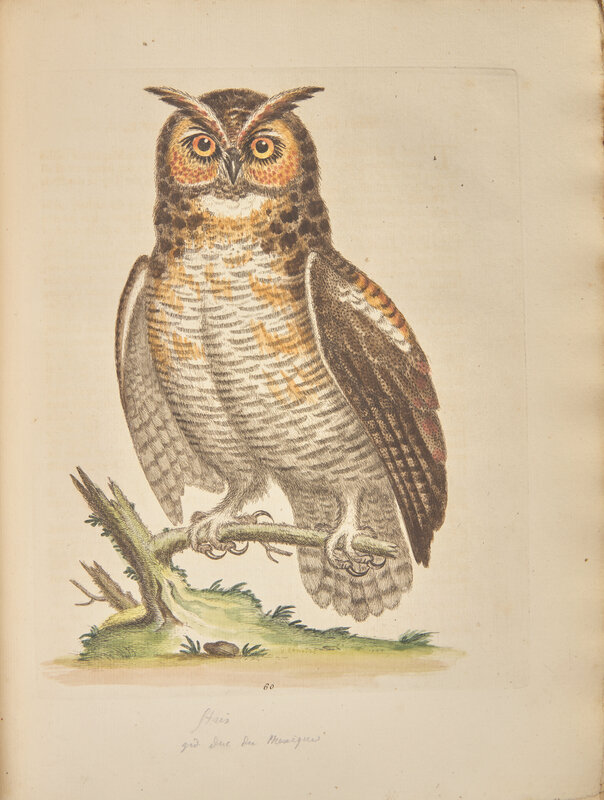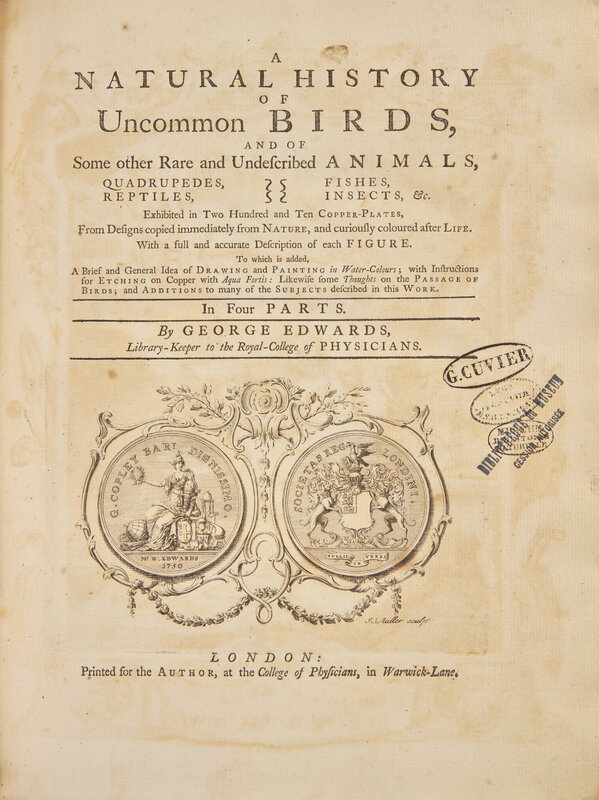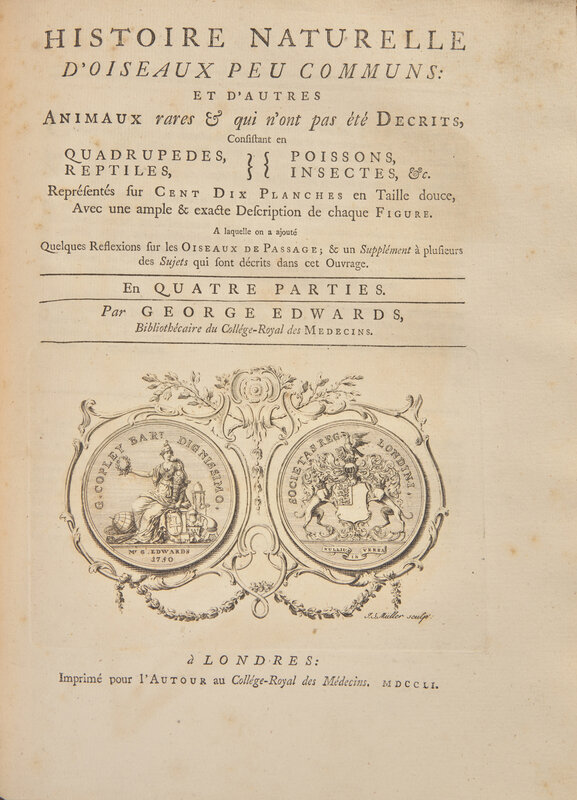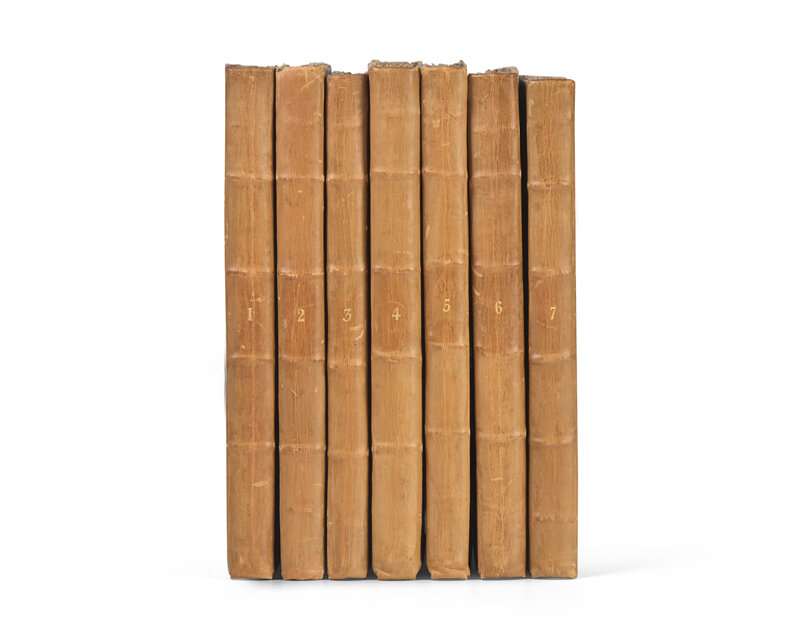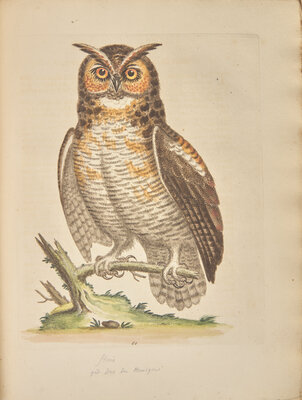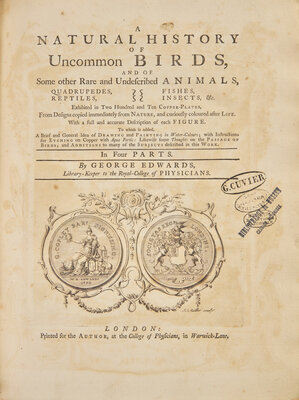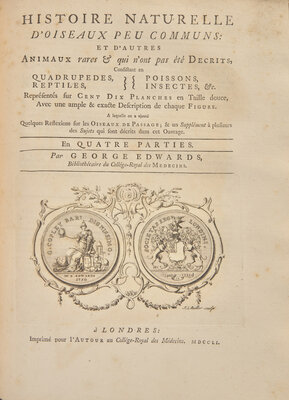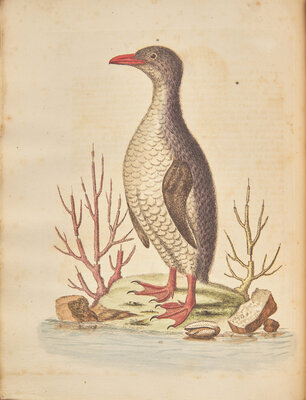Lot 118
[Natural History] [Cuvier, Georges] Edwards, George. A Natural History of Uncommon Birds, and of Some other Rare and Undescribed Animals…
Sale 2101 - Books and Manuscripts
Sep 10, 2024
10:00AM ET
Live / Philadelphia
Own a similar item?
Estimate
$7,000 -
10,000
Price Realized
$8,890
Sold prices are inclusive of Buyer’s Premium
Lot Description
[Natural History] [Cuvier, Georges] Edwards, George. A Natural History of Uncommon Birds, and of Some other Rare and Undescribed Animals…
From the Library of French Zoologist Georges Cuvier, the “Founding Father of Paleontology”
Edwards, George
A Natural History of Uncommon Birds, and of Some other Rare and Undescribed Animals…
London: Printed for the Author, (1743-51). Four parts in four volumes. First edition, first issue. From the library of French zoologist Georges Cuvier, and with his library ink stamps on title-page of each volume. Small folio, 12 1/4 x 9 1/2 in. (311 x 241 mm). (iv), xx, 52; (iv), 53-128; (iv), 106-157; (viii), 158-248, (1) pp.; first and second part without list of subscribers (but otherwise corresponding with Lisney). Illustrated with a hand-colored engraved frontispiece in first volume, engraved device on general title-page in same, 210 hand-colored engraved plates, and one uncolored engraved portrait plate (Samoyed); pencil annotations beneath each plate. Full contemporary blue paste paper-covered boards, sometime rebacked in tan calf, boards and extremities rubbed and lightly worn; all edges untrimmed; ink stamp of the “Museum d'Histoire Naturelle” on title-pages, and ink stamp “Bibliotheque du Museum Cession Autorisee” on same; light to moderate foxing to text and plates, scattered soiling to same; closed tear in bottom fore-edge of portrait plate. Sitwell, Fine Bird Books, p. 93; Zimmer, pp. 192-198; Lisney 188, 193, 198, 201; Anker 124, Mullens and Swann, pp. 195-196
Bound with the first French-language edition at end of each volume: Histoire Naturelle D'Oiseaux Peu Communs… London: Imprime pour l'Autour, 1751. In four parts: (x), xxi, lii, (1); (v), liii-cv, 26; (v), cvi-clvii; (iii), clviii-ccx, 211-236 pp. Translated by David Durand. Lisney 192, 197, 200, 203; Anker 125
Together with:
Edwards, George
Gleanings of Natural History, Exhibiting Figures of Quadrupeds, Birds, Insects, Plants, &c…
London: Printed for the Author, 1758-64. Three parts in three volumes. First edition. Small folio. (viii), 108; (xii), xxxv, (1), 109-220; (viii), vii, (i), 221-347 pp. Ink stamps as above on each title-page. Title-pages and text printed in English and in French. Illustrated with an engraved portrait of Edwards, engraved device on half-title, 152 hand-colored engraved plates, and an engraved tail-piece. Bound as above; many plates numbered in contemporary manuscript in black and red ink; light to moderate foxing and soiling to text and plates; plate 284 loose at bottom. Fine Bird Books, p. 93; Zimmer, pp. 192-198; Lisney 205, 208, 211; Anker 126
A fine association copy of one of the most important 18th-century works of natural history, from the library of influential French zoologist Georges Cuvier (1769-1832). "At its date of issue, the Natural History and Gleanings was one of the most important of all bird books, both as a fine bird book and a work of ornithology. It is still high on each list" (Fine Bird Books, p. 93).
Georges Cuvier was a major figure in the world of 19th century natural sciences, and is credited with establishing the fields of vertebrate paleontology and comparative anatomy, while making significant contributions to zoological taxonomy and the history of science. Considered one of the scientific giants of his age, Cuvier held several prominent positions within the French scientific establishment, most notably as professor of anatomy at the Musée National d'Histoire Naturelle. Among his many scientific accomplishments, Cuvier established that the extinction of animal species to be fact, and correctly connected one of extinction's causes to environmental catastrophe. Furthermore, he discovered and named the Mastodon and the prehistoric giant sloth Megatherium, while expanding Linnaean taxonomy by including fossils. Cuvier worked and lived at the Museum for most of his life, where he reorganized the Museum's vast anatomy collections under his novel classification schema, and conducted research that resulted in his seminal work, Le Règne Animal (1817). Within Le Règne Animal, Cuvier makes several references to Edwards's above work, declaring it the “richest collection of birds after the plates of Buffon…” (Tome IV, p. 115)
Georges Cuvier
Maggs Bros. Ltd., London, 1959, Catalogue 861, Item 75
Sotheby's, New York, February 2, 1985, Lot 13
Maggs Bros. Ltd., London, 1959, Catalogue 861, Item 75
Sotheby's, New York, February 2, 1985, Lot 13
Condition Report
Contact Information
Auction Specialist
